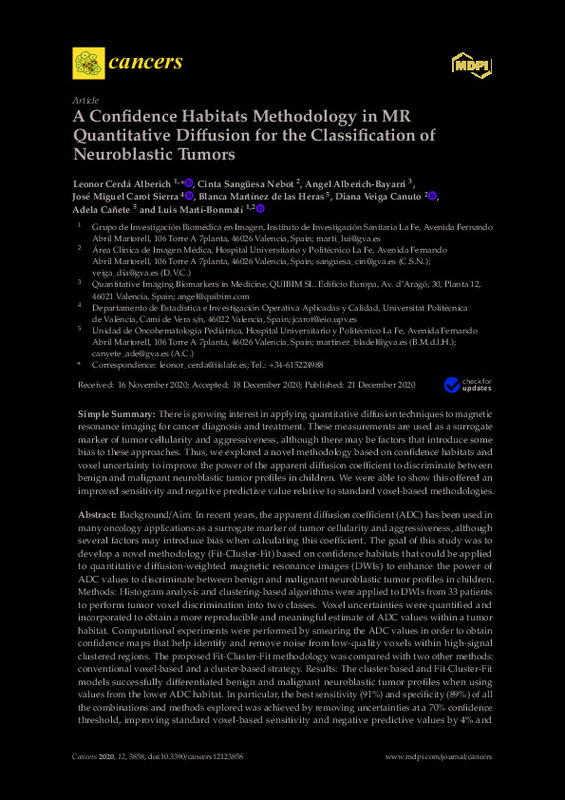JavaScript is disabled for your browser. Some features of this site may not work without it.
Buscar en RiuNet
Listar
Mi cuenta
Estadísticas
Ayuda RiuNet
Admin. UPV
A Confidence Habitats Methodology in MR Quantitative Diffusion for the Classification of Neuroblastic Tumors
Mostrar el registro sencillo del ítem
Ficheros en el ítem
| dc.contributor.author | Cerdà Alberich, Leonor
|
es_ES |
| dc.contributor.author | Sangüesa Nebot, Cinta
|
es_ES |
| dc.contributor.author | Alberich-Bayarri, Angel
|
es_ES |
| dc.contributor.author | Carot Sierra, José Miguel
|
es_ES |
| dc.contributor.author | Martinez de las Heras, Blanca
|
es_ES |
| dc.contributor.author | Veiga Canuto, Diana
|
es_ES |
| dc.contributor.author | Cañete, Adela
|
es_ES |
| dc.contributor.author | Martí-Bonmatí, Luis
|
es_ES |
| dc.date.accessioned | 2023-05-16T18:01:23Z | |
| dc.date.available | 2023-05-16T18:01:23Z | |
| dc.date.issued | 2020-12 | es_ES |
| dc.identifier.uri | http://hdl.handle.net/10251/193438 | |
| dc.description.abstract | [EN] There is growing interest in applying quantitative diffusion techniques to magnetic resonance imaging for cancer diagnosis and treatment. These measurements are used as a surrogate marker of tumor cellularity and aggressiveness, although there may be factors that introduce some bias to these approaches. Thus, we explored a novel methodology based on confidence habitats and voxel uncertainty to improve the power of the apparent diffusion coefficient to discriminate between benign and malignant neuroblastic tumor profiles in children. We were able to show this offered an improved sensitivity and negative predictive value relative to standard voxel-based methodologies. Background/Aim: In recent years, the apparent diffusion coefficient (ADC) has been used in many oncology applications as a surrogate marker of tumor cellularity and aggressiveness, although several factors may introduce bias when calculating this coefficient. The goal of this study was to develop a novel methodology (Fit-Cluster-Fit) based on confidence habitats that could be applied to quantitative diffusion-weighted magnetic resonance images (DWIs) to enhance the power of ADC values to discriminate between benign and malignant neuroblastic tumor profiles in children. Methods: Histogram analysis and clustering-based algorithms were applied to DWIs from 33 patients to perform tumor voxel discrimination into two classes. Voxel uncertainties were quantified and incorporated to obtain a more reproducible and meaningful estimate of ADC values within a tumor habitat. Computational experiments were performed by smearing the ADC values in order to obtain confidence maps that help identify and remove noise from low-quality voxels within high-signal clustered regions. The proposed Fit-Cluster-Fit methodology was compared with two other methods: conventional voxel-based and a cluster-based strategy. Results: The cluster-based and Fit-Cluster-Fit models successfully differentiated benign and malignant neuroblastic tumor profiles when using values from the lower ADC habitat. In particular, the best sensitivity (91%) and specificity (89%) of all the combinations and methods explored was achieved by removing uncertainties at a 70% confidence threshold, improving standard voxel-based sensitivity and negative predictive values by 4% and 10%, respectively. Conclusions: The Fit-Cluster-Fit method improves the performance of imaging biomarkers in classifying pediatric solid tumor cancers and it can probably be adapted to dynamic signal evaluation for any tumor. | es_ES |
| dc.description.sponsorship | This study was funded by PRIMAGE (PRedictive In-silico Multiscale Analytics to support cancer personalized diaGnosis and prognosis, empowered by imaging biomarkers), a Horizon 2020 vertical bar RIA project (Topic SC1-DTH-07-2018), grant agreement no: 826494. | es_ES |
| dc.language | Inglés | es_ES |
| dc.publisher | MDPI AG | es_ES |
| dc.relation.ispartof | Cancers | es_ES |
| dc.rights | Reconocimiento (by) | es_ES |
| dc.subject | Tumor clustered habitats | es_ES |
| dc.subject | Confidence maps | es_ES |
| dc.subject | Data smearing | es_ES |
| dc.subject | Uncertainty exclusion | es_ES |
| dc.subject | Reproducible imaging biomarkers | es_ES |
| dc.subject.classification | ESTADISTICA E INVESTIGACION OPERATIVA | es_ES |
| dc.title | A Confidence Habitats Methodology in MR Quantitative Diffusion for the Classification of Neuroblastic Tumors | es_ES |
| dc.type | Artículo | es_ES |
| dc.identifier.doi | 10.3390/cancers12123858 | es_ES |
| dc.relation.projectID | info:eu-repo/grantAgreement/EC/H2020/826494/EU | es_ES |
| dc.rights.accessRights | Abierto | es_ES |
| dc.contributor.affiliation | Universitat Politècnica de València. Escuela Técnica Superior de Ingenieros Industriales - Escola Tècnica Superior d'Enginyers Industrials | es_ES |
| dc.description.bibliographicCitation | Cerdà Alberich, L.; Sangüesa Nebot, C.; Alberich-Bayarri, A.; Carot Sierra, JM.; Martinez De Las Heras, B.; Veiga Canuto, D.; Cañete, A.... (2020). A Confidence Habitats Methodology in MR Quantitative Diffusion for the Classification of Neuroblastic Tumors. Cancers. 12(12):1-14. https://doi.org/10.3390/cancers12123858 | es_ES |
| dc.description.accrualMethod | S | es_ES |
| dc.relation.publisherversion | https://doi.org/10.3390/cancers12123858 | es_ES |
| dc.description.upvformatpinicio | 1 | es_ES |
| dc.description.upvformatpfin | 14 | es_ES |
| dc.type.version | info:eu-repo/semantics/publishedVersion | es_ES |
| dc.description.volume | 12 | es_ES |
| dc.description.issue | 12 | es_ES |
| dc.identifier.eissn | 2072-6694 | es_ES |
| dc.identifier.pmid | 33371218 | es_ES |
| dc.identifier.pmcid | PMC7767170 | es_ES |
| dc.relation.pasarela | S\427586 | es_ES |
| dc.contributor.funder | European Commission | es_ES |








